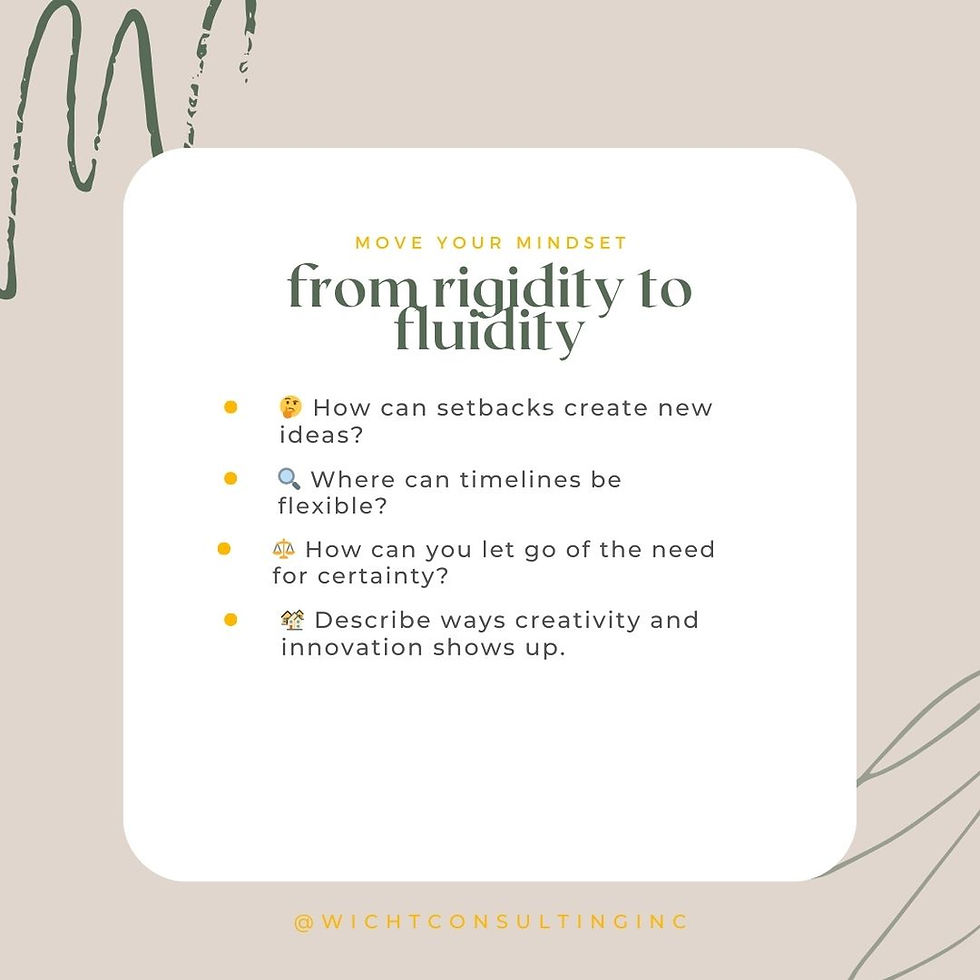Moving from Rigidity to Fluidity: Finding Strength in Adaptability
- sarawicht

- Sep 11
- 4 min read
What if your greatest breakthroughs actually come from embracing uncertainty? In a world that demands detailed plans, firm deadlines, and predictable outcomes, we've been trained to see flexibility as weakness. But what happens when our rigid adherence to plans actually prevents us from discovering better possibilities?
Why Workplace Cultures Reward Rigidity
Our organizational systems are built on the industrial model: standardized processes, measurable outcomes, and minimal deviation from established procedures. This structure emerged from assembly-line thinking, where consistency and predictability drove efficiency and profit.
Modern workplaces perpetuate this rigid framework through quarterly planning cycles that resist mid-course corrections, performance metrics that penalize experimentation, and leadership styles that mistake adaptability for indecision. We've created environments where changing direction, even when new information suggests a better path, is seen as failure rather than wisdom.
This rigidity becomes especially problematic in our diverse, globally connected workplaces. Different cultures have varying relationships with time, planning, and uncertainty. Some cultures value detailed preparation while others prioritize adaptive responsiveness. When we impose rigid structures without considering these differences, we miss opportunities for innovation that emerge from cultural fluidity.
The cost of this inflexibility? We miss breakthrough solutions that require pivoting, we exhaust ourselves trying to control uncontrollable variables, and we create stress-inducing environments that stifle that very creativity we need to thrive in uncertain times.
The Hidden Power of Fluid Thinking
Fluidity isn't about abandoning structure--it's about building resilience and responsiveness into how we work. The most successful organizations and leaders have learned to hold their plans lightly, treat setbacks as valuable information, and view uncertainty as a creative opportunity.
When we embrace fluid thinking, we discover:
Setbacks often contain the seeds of better solutions than our original plans
Timelines can stretch and compress to accommodate real-world complexity
Innovation emerges when we stop trying to control every variable
Different cultural approaches to time and planning can enhance rather than complicate our work
This shift from rigid to fluid thinking doesn't require abandoning goals or accountability. It requires developing the capacity to navigate toward outcomes through changing conditions rather than despite them.

Three Practical Exercises: Developing Fluid Responsiveness
Exercise 1: The Setback Innovation Practice
The next time you encounter a significant setback or obstacle at work:
Before jumping into problem-solving mode, pause and ask: "What is this setback trying to teach us?"
Gather diverse perspectives on what this obstacle might reveal about assumptions, timelines, or approaches that need adjusting.
Specifically seek input from colleagues with different cultural backgrounds. Ask how they might approach this challenge differently.
Identify at least three new possibilities that this setback has revealed.
Choose one unexpected direction to explore, even if it feels uncertain.
This practice transforms setbacks from failures into information and helps you recognize how different cultural approaches to obstacles can expand your solution set.
Exercise 2: The Timeline Flexibility Experiment
Select a current project with established deadlines:
Map out which timeline elements are truly fixed (external deadlines, resource constraints) versus those that are assumed or traditional.
Identify where cultural differences in time orientation might offer alternative approaches (some cultures prioritize relationship-building time, others value efficiency).
Experiment with one timeline adjustment that allows for more organic development or iterative improvement.
Notice how this flexibility affects both process and outcomes.
Document what you learn about the relationship between rigid scheduling and creative output.
This exercise helps distinguish between necessary structure and unnecessary rigidity while exploring how different cultural relationships with time can inform more inclusive planning.
Exercise 3: The Uncertainty Creativity Challenge
Practice working with uncertainty as a creative partner:
Choose one area where you've been seeking certainty before moving forward.
Instead of trying to eliminate uncertainty, ask: How might this unknown element enhance our approach?
Invite input from colleagues who come from cultures with different comfort levels around uncertainty.
Design one small experiment that moves forward without complete information.
Pay attention to what emerges when you work with uncertainty rather than against it.
This practice builds comfort with not-knowing and reveals how different cultural approaches to uncertainty can unlock possibilities.
Fluidity as Intercultural Competence
One of our richest sources of fluid thinking comes from intercultural collaboration. Different individuals and groups of people have varying relationships with planning, time, and adaptation. Some prioritize detailed preparation while others excel at responsive improvisation. Some see uncertainty as threat while others view it as opportunity.

When we approach intercultural work with fluidity:
We recognize that multiple valid approaches to planning and execution exist.
We learn from different cultural wisdom about navigating uncertainty.
We create space for various time orientations and working styles.
We discover innovative solutions that emerge from combining diverse approaches to flexibility.
This cultural fluidity transforms not just how we work across difference, but what becomes possible when we do.
Moving Forward: From Individual Adaptation to Organizational Agility
Fluid thinking isn't just about personal resilience. It's about creating workplace cultures that can respond gracefully to change while maintaining their core purpose and values.
When we build fluidity into our systems, we create conditions for faster recovery from setbacks and unexpected challenges. Innovation emerges from iterative experimentation, and inclusive approaches honor different relationships to time and planning. Instead of breaking under pressure, sustainable growth adapts to changing circumstances.
Ready to Embrace Fluidity?
Developing comfort with uncertainty and adaptability is essential for effective intercultural collaboration, where rigid expectations often clash with diverse approaches to work and relationships. If you're ready to explore how fluid thinking could transform your leadership effectiveness and cross-cultural collaboration, I'd love to support your journey.
Through 1:1 Cultural Competency Coaching (CCC), you'll gain insight into how rigidity might be limiting your intercultural effectiveness, develop strategies for working fluidly across difference, and engage in targeted practices that build your capacity to navigate uncertainty with confidence.
Schedule a conversation to explore!




Comments